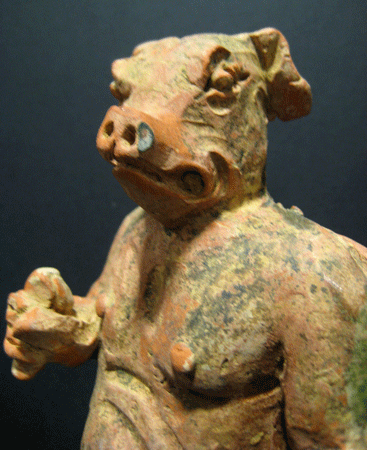Zodiac Figurine of the Year of the Pig, 1368 CE - 1644 CE
Terracotta
9
LA.519
Further images
Glazed pottery figurine depicting an anthropomorphic pig painted in pink, emerging from a swirl of green coloured clouds, a short green mantel covering his shoulders. Numerology and astrology have been...
Glazed pottery figurine depicting an anthropomorphic pig painted in pink, emerging from a swirl of green coloured clouds, a short green mantel covering his shoulders.
Numerology and astrology have been integral part of Chinese culture from the beginning. Association of animals with directions, times of the year, certain constellations and specific qualities were central in the yin-yang wuxing (Yin and Yan and five elements) belief of the Han dynasty. The appearance of certain animals played an important role in Chinese beliefs regarding omens and portents and reflected a complex and evolving system of belief that spanned the Han dynasty through the period of disunity into the Tang dynasty.
Yet the origin of the twelve zodiac signs remains somewhat obscure; their earliest appearance as funerary sculptures in northern Chinese tombs dates to the latter part of the Six dynasties period (6th c. C.E).
Almost all early examples represent human bodies, in kneeling position with animal heads; no full set has been found so far from tombs datable to this period.
The earliest known 12 piece sets date from the Tang dynasty, but they are extremely rare. Sets of Zodiac animals become common only later in the Tang dynasty and during the Song.
Zodiac animals might have been inspired by contacts with Western and Central Asian peoples, given the fact that their first appearance coincided with the advent of the Tuoba Wei dynasty in Northern China, indeed the animal zodiac constituted a well-developed iconographical element in these areas long before their emergence in China.
Numerology and astrology have been integral part of Chinese culture from the beginning. Association of animals with directions, times of the year, certain constellations and specific qualities were central in the yin-yang wuxing (Yin and Yan and five elements) belief of the Han dynasty. The appearance of certain animals played an important role in Chinese beliefs regarding omens and portents and reflected a complex and evolving system of belief that spanned the Han dynasty through the period of disunity into the Tang dynasty.
Yet the origin of the twelve zodiac signs remains somewhat obscure; their earliest appearance as funerary sculptures in northern Chinese tombs dates to the latter part of the Six dynasties period (6th c. C.E).
Almost all early examples represent human bodies, in kneeling position with animal heads; no full set has been found so far from tombs datable to this period.
The earliest known 12 piece sets date from the Tang dynasty, but they are extremely rare. Sets of Zodiac animals become common only later in the Tang dynasty and during the Song.
Zodiac animals might have been inspired by contacts with Western and Central Asian peoples, given the fact that their first appearance coincided with the advent of the Tuoba Wei dynasty in Northern China, indeed the animal zodiac constituted a well-developed iconographical element in these areas long before their emergence in China.







